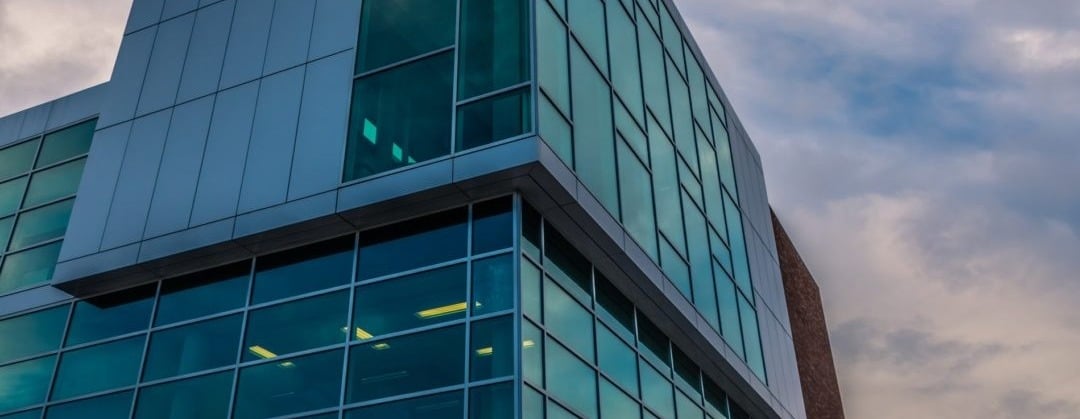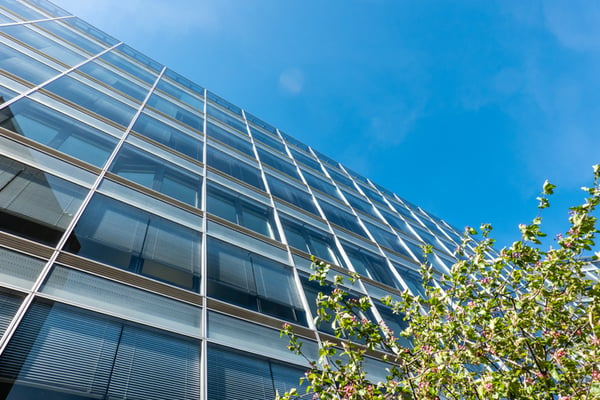
Since reinforced concrete and structural steel entered the picture, engineers have learned that thinner columns could still support a building. Even more interesting, they could exist independent of the exterior, meaning outer walls no longer had to shoulder structural loads.
Today these outer “curtain” walls offer amazing aesthetics, but they still also serve an important role in sustainability and protecting a building envelope.
Exactly what is a curtain wall in construction, and what part does it play in protecting your build for the long term? Let’s talk more about curtain wall construction, including an in-depth explanation of each type, their materials and products, and their overall benefits.
Definition: What Is a Curtain Wall?
A curtain wall system is a thin, framed external structure consisting of fill-ins and non-structural partitions. It’s grown into arguably the most popular glazing system – just look around you.
Consider the sweeping skyscrapers you see in the city. The sleek, floor-to-ceiling glass walls and framed windows make up a curtain wall system.
How do these walls hold up the entire building? They don’t. The framing is attached to the building structure and doesn’t carry any of its load.
So they’re just an aesthetic feature of the architecture, right? Nope again. In most uses, commercial curtain wall systems have a huge job – protecting the building envelope design’s integrity from:
- Water
- Cold & hot air
- UV radiation
While these walls are thin, they can hold up against the elements. This is because they use corrosion-resistant materials and any forces they endure (i.e. wind) transfer to the connected building structure.
Curtain wall construction requires assembly materials for gasketing, glazing, structural adhesion, weatherproofing, and more.
What Isn’t a Curtain Wall?
Sometimes people confuse or compare curtain walls with similar elements of a building’s envelope.
-
Curtain walls vs. window walls: Curtain walls are suspended over the building’s structural elements, providing no support, and extend beyond the length of one floor. Window walls set glass within a wall’s structural components, and each unit is only one floor long.
-
Curtain wall vs. storefronts: Units of a curtain system are also taller than the typical storefront component, which is generally 10-12 ft.
Curtain Wall Materials
A curtain wall gets its unique look from two external cladding components: frames and infills.
Frames
When choosing a framing material for a curtain wall, steel vs. aluminum is almost always the debate.
Aluminum has become a familiar face in building design because of its impressive strength-weight ratio. It has other advantages too:
- Readily available
- Naturally forms a corrosion-resistant layer
- Adaptable to many design ideas
Steel framing is making a bit of a comeback for glazed curtain walls thanks to advances in material grades and forming technology. While steel is inherently heavy, the right system can support larger wind and glass loads.
Wood has grown into another viable option in the right situation. Timber and glue-laminated members can bring a unique aesthetic, but that also means sourcing it is a bit unconventional. The process often involves coordinating with a glazing subcontractor, who can apply a glass receptor system to the members to receive the glazing infill.
Infill
Infills (aka spandrel panels) take up the vast majority of space in a curtain wall, as they’re the large panels that go between each mullion. Infill options are a little broader than framing options:
- Glass: A popular choice due to its near-infinite customizability in color and opacity. In commercial glass construction, 1⁄4 inch monolithic is common in spandrel areas, while 1 in. insulating glass is often the choice elsewhere on the building.
- Metal panels: Aluminum, steel, and even copper wall cladding are available, providing a nice range of design possibilities. Since these metals can withstand harsh weather conditions, they’re excellent for projects where longevity and low maintenance are key.
- Stone veneers: These infills elegantly replicate the appearance of natural stone, adding a timeless charm that’s hard to beat. However, weight and installation considerations should factor into your potential purchase.
- Louvers: They provide excellent airflow and light management, adding to a building's energy efficiency. On the downside, they may require additional maintenance over time.
- Windows & vents: These provide must-have ventilation and emergency exits. Choosing the right type will depend on building codes, energy efficiency requirements, and aesthetic tastes.

Types of Curtain Walls
Everyone in the construction world seems to develop their own language, and it’s no different with curtain walls. There are two ways builders categorize them:
- By build type
- By how they’re glazed
By Build Type
Builders may also refer to curtain walls by their method of assembly. Your project requirements will likely push you toward one system over the other.
Stick Systems
Stick-built curtain wall systems are the traditional method, assembled in the field with inside or outside glazing. They’re most common in small buildings with low required volumes, but complex conditions.
After fabrication off-site, the manufacturer ships the components to the job location. By sealing and glazing on-site, transportation is simpler.
Other stick system facts to consider:
- Less staging required up-front
- Lower shipping cost
- Higher labor cost
- Assembly process is slow
Unitized/Modular Systems
This is often the system of choice for tall buildings.
The unitized curtain wall installation process starts right in the factory. The manufacturer handles fabricating, assembling, glazing, and sealing the parts. Only then does the curtain wall head to the job site (carefully, due to its size), where a separate field team works on installation.
Advantages and drawbacks of unitized glazing include:
- Faster assembly on-site
- Higher quality
- Lower installation cost
- High transportation cost
- Staging can take 6-12 months
By Glazing
You can also choose curtain wall types based on how the glass is held to the wall structure.
Fully Captured
As “conventional” as it gets in this relatively new field, fully captured curtain walls are aluminum-based systems. They use gaskets and pressure plates to surround the glazing on all sides.
Fully captured varieties are straightforward to install and are compatible with a wide variety of building types. On the downside, their components can conduct a lot of heat in or out of the facade.
2-Sided
This newer option introduces a different approach of bonding the glazing to the mullion.
In two-sided structural glazing, there are still mechanical supports on two sides of the unit. On the other two sides, wet-sealed or extruded silicone replaces the traditional gaskets and plates. The sealant must be approved for structural use.
Structural silicone glazed (SSG) systems create a clean and smooth visual, as fewer visual breaks and external accessories get in the way.
4-Sided
Four-sided systems take the idea a step further in the name of sustainability. Four-sided structural glazing includes silicone joint sealant on all edges of the glazing. Note that some sealants approved for use on two-sided systems aren’t usable in four-sided systems.
These systems offer similar aesthetic benefits as their two-sided sisters, while also improving energy efficiency. The downsides are added cost and vulnerability to poor field conditions during installation.
Curtain Wall Protection: Assembly Products
Something has to affix all that architectural glass and metal paneling safely to the structure. This often happens through adhesives, chemical bonding, or mechanical bonding.
Then there’s the matter of keeping it all in place. Curtain wall installers rely on a variety of weatherproofing products to stave off water, air, and UV rays:
- Joint sealants
- Weatherseals for window walls
- Glazing & bonding structural tape
- Expansion joints
- Pre-molded silicone sheets/boots (inside & outside corners)
- Paintable caulking
- Two-part, fast-cure silicone for on-site reglaze repairs
These products protect your curtain wall in two ways: from sudden water intake, and from gradual wear and tear. If you’re new to curtain wall products, an experienced distributor can help you with material selection, in-field and shop adhesion testing, and warranty support.
Curtain Walls & Water Ingression
To fully grasp the importance of a curtain wall, think about what causes the ingression of water. Five major forces are to blame:
- Gravity
- Kinetic energy
- Capillary action
- Surface tension
- Air pressure
To withstand these forces, the curtain wall must also be glazed and incorporate drainage details, interior sealants, perimeter flashings, and more. They must also account for thermal expansion in any of the included materials.
The best way to avoid leaks is to identify any forces the curtain wall will likely be under. From there, make sure it has expansion joints, seals, and gaskets to account for the inevitable thermal expansion.
Long-Term Maintenance
Maintenance means more than just keeping a glass curtain wall nice and shiny. Regular upkeep also boosts protective performance.
For extra safeguarding, apply sealant compounds every 10 years after installation. In general, prompt and proactive repair of chips, cracks, and other damage will promote a better-looking, longer-lasting glaze job.
Beware of Product Compatibility!
This one’s been a hot topic among the large glaziers, particularly in unitized/modular builds.
It’s a must that the field and in-shop teams operate in conjunction – not just literally, but also when selecting products. The entire curtain wall design process requires both sides to use materials suitable for the project – and communicate with each other about those materials.
Educating Yourself on Weatherproofing Products
A curtain wall is a vertical facade for many of the latest and greatest commercial construction projects. From office buildings to other uses, they bring aesthetic impact while still excelling at what’s most important – protecting the building and its occupants.
For more tips on structural glazing and related products, visit our full resource hub:

